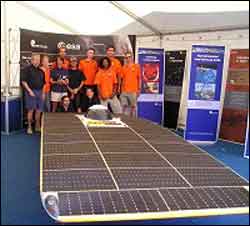Scandinavian Nuna II tour begins in sunny Oslo

Nuna II on show in Oslo
Gazing out of the small aircraft window, the endless woods and the numerous lakes caught the eye as we flew from the rainy Netherlands towards beautiful Norway. The assumption that all Norwegians have a sailing boat came to mind, since almost every lake and every fjord has a small harbour with hundreds of boats. It is hard to imagine that these people would not be excited about other means of sustainable transport like the Nuna II.
The Nuna II team and the support crew were welcomed to the capital of Norway by the Dutch ambassador Mr Ader and his wife at their residence. It was a sunny evening and during the buffet the different groups got to know each other in the ambassador´s garden.
Next morning the tour really began. The solar car departed from the Norsk Romsenter (Norwegian Space Centre) garage and drove through central Oslo towards Akke Brygge. Most team members were new to riding in convoy so it was a bit hectic. The spectacular car caused many heads to turn and attracted a lot of attention as it drove along the quay to its exhibition tent.
At the Oslo Fjord the Scandinavian Grand Prix was taking place, the Formula 1 race for power boats. Nuna II got a central spot at the exhibition, between Koenigsegg, Landrover and Honda. During the hot August day, fast racing boats chased each other in the Fjord as helicopters hovered over them.
Thousands of people were visiting the festivities and Nuna II attracted nearly everyone’s attention. Younger visitors were especially excited about the revolutionary car. We were struck by the positive spirit among the Norwegian people concerning the sustainable aspects of the Nuna II. They were particularly interested in the applicability of the solar technique to normal cars.
Later in the evening the team headed off for the Olympic ski jumping hill Holmenkollen for a refreshing swim in the pool beneath it. The sun behind the mountain, marking the end of a successful first day for the Nuna II tour.
Nuna II is the fastest solar-powered car on Earth, with top speeds of 170 km/h, thanks to leading-edge technologies from Europe’s space programmes, and is currently on tour in Sweden and Norway.
Travelling 3010 km in 31 hours and five minutes, Nuna II won the World Solar Challenge in Australia in October 2003. The car was built and driven by students from Delft University in The Netherlands.
ESA provided through its Technology Transfer Programme several of the key technologies onboard Nuna: solar cells, batteries, power control system and lightweight carbon-fibre plastics, all been developed for European satellite systems.
In particular the high-efficiency solar cells were novel technologies first flown on the SMART-1 satellite, built by the Swedish Space Corporation as prime contractor. The use of these cells and the other space technologies on a solar powered car is an excellent demonstration of the potential of space technology in sustainable transportation.
The Nuna II is visiting Sweden and Norway 14-22 August 2004 and touring nine cities, all with industries, research centres and universities active in the space field. The solar car will stop in Oslo, Gothenburg, Linköping, Stockholm, Uppsala, Luleå, Kiruna, Narvik, and Andenäs.
Media Contact
More Information:
http://www.esa.intAll latest news from the category: Transportation and Logistics
This field deals with all spatial and time-related activities involved in bridging the gap between goods and people, including their restructuring. This begins with the supplier and follows each stage of the operational value chain to product delivery and concludes with product disposal and recycling.
innovations-report provides informative reports and articles on such topics as traffic telematics, toll collection, traffic management systems, route planning, high-speed rail (Transrapid), traffic infrastructures, air safety, transport technologies, transport logistics, production logistics and mobility.
Newest articles

High-energy-density aqueous battery based on halogen multi-electron transfer
Traditional non-aqueous lithium-ion batteries have a high energy density, but their safety is compromised due to the flammable organic electrolytes they utilize. Aqueous batteries use water as the solvent for…

First-ever combined heart pump and pig kidney transplant
…gives new hope to patient with terminal illness. Surgeons at NYU Langone Health performed the first-ever combined mechanical heart pump and gene-edited pig kidney transplant surgery in a 54-year-old woman…

Biophysics: Testing how well biomarkers work
LMU researchers have developed a method to determine how reliably target proteins can be labeled using super-resolution fluorescence microscopy. Modern microscopy techniques make it possible to examine the inner workings…





















